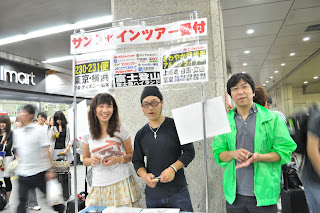*natsukashii naa!
 | ||
| 'Welcoming' me to Japan with a nihonjinron lecture in Kyoto JR Station. |
Over the term, I’ve had a few existential crises in which I despaired over whether I, as a non-Japanese, could even legitimately begin to study this culture, and whether a desire to study it wasn’t inherently “Other”-izing my subjects. I’ve butted my head against the realization that some of my own past conceptions of Japan were, without knowing the proper term for it, based in ideas that smacked frighteningly of nihonjinron. I’ve realized how glad I am to be receiving an education in the United States, and as a woman, to be a citizen of the United States – before coming to Japan, my study of Japanese film and the language had given me a general sense that Japanese women had it a lot worse than Japanese men. Living here, as a girl, and taking a Gender and Sexuality course with Professor Hester, I’ve had the opportunity realize the complexity of the plight of Japanese women, and also that gendered oppression in Japan isn’t restricted to female-identified people, although they certainly have been getting the short end of the stick in terms of things like higher education, career-tracking, and marital division of labor.
But being in Japan has also changed the way I think about or orient myself to ‘the West.’ Before I came to Japan, I don’t remember myself being particularly nostalgic – or at least, I don’t remember expressing my ‘nostalgia’ quite so often. But now 懐かしい - natsukashii - is a staple of my vocabulary, and I wonder whether it is bringing out fond memories I didn’t know I had, or reflecting, through its linguistic existence, the current Japanese tendency to be, for lack of a better English word, ‘nostalgic’ about the past – particularly the recent past. As other bloggers and scholars have noted, the Japanese word “natsukashii” has no exact equivalent in English, although ‘nostalgic’ probably comes the closest.
 |
| This giant Christmas tree in Harajuku is the kind of thing that makes me ちょっと懐かしい for America... |
Admittedly, I’ve spent a fair amount of the past 4 months feeling natsukashii about things I never expected to – the Seattle’s Best coffee shop on campus (I’m from Olympia, Washington…), anything vaguely Christmas-like, the overwhelming Western influence at USJ, an Our Family shopping bag at seminar house four (from a grocery chain native to my scholastic home-base of Minnesota…). In America, I would never feel that way about a chain coffee shop or shopping tote (I feel that way about Christmas every year), so I wonder how much of this nostalgia is constructed through distance – in a way, am I exoticizing my own memories of the West, seeing it through the cultural lens of my life in Japan? Perhaps this distance is at the root of akogare – the feeling of longing that the Japanese purportedly have for things Western (read: American, usually) – and as I feel it, I am in fact getting more in touch with some aspect of being fully in Japan. Or maybe I’ve just been homesick all along – who knows? Probably some of both. Maybe because I came into contact with so much constructed nostalgia for the West, I felt that if people who had never even been to America could long for it, shouldn’t I, an American away from home, feel even more strongly?
I am, however, already beginning to feel preemptively natsukashii about things Japanese, with my flight home less than 12 days distant on the calendar:
Konomiya, where I grocery shop every Monday evening after choir to take advantage of the store-wide 10% discount…
 |
| Japanese milk cartons! Never larger than a liter. How frustrating for someone like me... |
Settling in for a (marginally) restful night’s sleep on a 夜行バス (yakou basu) bound for Fuji or Tokyo…
 |
| I always take off from Kyoto JR on the Sunshine Tours night buses run by these friendly folks! |
Riding my Japanese-style mamachari bicycle all over Hirakata, and their general ubiquitousness…
Being stared at in public baths…
 |
| Me, enjoying the complimentary yukata at the famous Dogo Onsen in Matsuyama. |
The importance of lunch dates between foreign and native students at Kansai Gaidai…
 |
| The dining hall at Kansai Gaidai! |
Genkan, or entryways, and having gotten used to automatically taking my shoes off and putting on slippers instead…
Matcha softcream. 美味しい...
 |
| Matcha and hakone salt twist - an excellent reward while biking the Shimanami Kaido from Onomichi to Imabari! |
The way that Haru, my wonderful, spirited, hard-working, lovely home-visit partner, welcomed me into her home and her life…
 |
| USJ, which made me natsukashii for America, but now makes me natsukashii for my time in Japan and with Haru... |
Of all the many changed and changing impressions that I have of Japan, the one I feel most acutely as I write this last blog is the shift in the direction of my natsukashii kanji – from America to Japan. But, everything that I know I will miss about Japan is simply a reason to return – to allow Japan, and everything visual and anthropological about it, to find its way into my future.








































